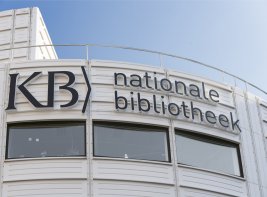The KB is working with partners on the digital infrastructure needed to put the written word to work and provide it to others. This is how we give the public access to our joint collections and work on new search methods. We also make sure you can easily log in to our services and work on replacing outdated software programs. All this is done with a view to the future.
What is the KB's digital infrastructure?
The KB collaborates with local libraries, heritage institutions and universities to work together in a digital infrastructure. This is a shared landscape of software programs and hardware – computers and other devices – in which we can exchange digital information.
We use the KB digital infrastructure to connect the content and public services of local public libraries with each other and with those of the KB. This is done under the banner of the national digital public library. We build facilities that enable local libraries to carry out their digital services in the best possible way. Consider, for example, a platform for e-books, a national library catalogue (NBC) and a shared website (Website as a Service, WaaS). We also provide a facility to register and recognise users (AV/KRS) and a data warehouse to collect and report information from and about libraries (DWH).
Under the banner of the Dutch Digital Heritage Network (NDE), we are building a joint network with heritage institutions. Examples include the National Archives, Heritage Brabant, the Netherlands Institute for Sound and Vision, the Cultural Heritage Agency and the Royal Netherlands Academy of Arts and Sciences (KNAW). We want to increase the social value of our shared collections by linking them, for example through Linked Data. That way, you will soon be able to show information from different collections and databases together with one search. We also want to ensure that collections are used as much as possible.
The KB also collaborates with partners from the academic world, mainly university libraries. We work with them to make our joint collections accessible to the public and researchers.
Onder de vlag van het Netwerk Digitaal Erfgoed (NDE) bouwen we aan een gezamenlijk netwerk met erfgoedinstellingen. Denk bijvoorbeeld aan het Nationaal Archief, Erfgoed Brabant, Nederland instituut voor Beeld en Geluid, de Rijksdienst Cultureel Erfgoed en de Koninklijke Nederlandse Akademie van Wetenschappen (KNAW). We willen de maatschappelijke waarde van onze gezamenlijke collecties vergroten door ze met elkaar in verbinding te brengen, bijvoorbeeld via Linked Data. Op die manier kun je straks met 1 zoekactie informatie uit verschillende collecties en databanken samen laten zien. Ook willen we ervoor zorgen dat de collecties zoveel mogelijk worden gebruikt.
Ook werkt de KB samen met partners uit de wereld van de wetenschap. Het gaat vooral om universiteitsbibliotheken. Met hen werken we samen om onze gezamenlijke collecties toegankelijk te maken voor publiek en onderzoekers.
The importance of good digital infrastructure
As a national library, we want to put the written word to work to contribute to a smarter, more skilled and more creative Netherlands. We live in a digital age. That’s why it is important for our infrastructure to also be digitally sound. We renew old parts and do our best to maintain compliance with the latest guidelines, for example in the field of safety. Tackling this as a network ensures the proper division of tasks and prevents the duplication of work.
What have we achieved so far?
We’ve worked hard on the national digital infrastructure for public libraries over recent years. We are constantly developing all components and linking them together. All libraries now have access to the e-book platform, the national library catalogue, AV and the DWH. The next step is to develop Single Identity, which gives you access to all library services with one login.
Along with our partners from the world of academic heritage, we worked hard to create a new joint infrastructure. We explored our visions and the market. For example, we are looking into how we can set up our collection systems to work with linked data. We do this according to the principles of the Digital Heritage Reference Architecture (DERA).
We are also working on our own infrastructure by, for example, making great strides in revamping our digital warehouse.

